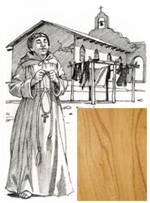16 Comments
Nice one Mike, I think a 12" is Plenty big too. Are you sawing wet wood or dry? I re-sawed a piece of wet hickory and gummed up the blade almost instantly.
Take it easy lifting those logs.
This Chinaberry is wet. One thing that I started doing even before this, is to lubricate the blade with WD40 on a paper towel (of course with the motor OFF). I have also used PAM, as well as that chemical tar remover from Grizzly. Anyway, in the long run, just keeping a bit of lubricant on the blade makes the cut easier and the blade will gunk up much less. My biggest issues were with Pine… 8-(
HorizontalMike
Well done Mike !….That sure is some gorgeous wood too. If it were mine it might be hard to wait out the air drying time ( about a year +/- I’m guessing ??) before I would want to use it….
Measure "at least" twice and cut once
Chinaberry? Is that with the red berries about 3/4" round that smell like dog poop when you step on them?
Losing fingers since 1969
Yes it is – but the berries are yellow. There were a few in front of my old apartment building in NYC and chinese people would pick up the drops. I can’t imagine what they do with them because they stink something awful. Has a pretty wood grain, though.
Losing fingers since 1969
Never heard of china berry.
Cool project. One I will copy.
How hard is it to move the log after the first cut and realign it?
Abbas, Castro Valley, CA
The Chinaberry was gifted to me, already cut and stacked. The way I understand it is that the berries are toxic, as in death possible, if ingested. It is a non-native and considered invasive. Chinaberry is a member of the mahogany family and is a perennial. More information here and also HERE.
As far as realigning the log on the sled, I have lines drawn 1in apart all across the base. Do understand that when you put a log on the sled you will NOT necessarily put it in parallel fashion, especially if it contains a crotch. That said, you then advance each side 1in at a time accordingly (or 2in if that is what you want).
I always throw away that last piece attached to the sled if it is 2in or less. Remember, I use 2in screws through 3/4in ply to attach the log to the sled, and I don’t want to sacrifice a $30-$50 blade trying to squeak out “just one more piece”.
HorizontalMike
Here is some very interesting information about the Chinaberry in American folklore. This must have been a more recent addition, as I didn’t find anything about it in my ~30yr collection of WOOD mags.
From WOOD Magazine.com:
http://www.woodmagazine.com/materials-guide/lumber/wood-species-1/chinaberry/
The answer to many a prayer

Seldom has a transplant been as happy as the chinaberry tree. Introduced to the sundrenched American Southwest and Mexico centuries ago for shade, the chinaberry embraced its arid new home and flourished. This cousin of mahogany from China relished the hot, dry climate and responded to it with rapid growth in even the worst of soil.
Native Americans, Mexicans, and new settlers in the barren land welcomed the new tree. Indeed, people cooled off beneath its branches, but didn’t hesitate to fell it for wood the worked into rustic furniture and tool handles, and burned for fuel. Still, the chinaberry offered them much, much more.
When denied the luxury of real soap or its ingredients, the resourceful sought out the generous chinaberry. By mashing its large, yellow, berrylike fruits and adding them to water, they whipped up a cleansing bath for grimy clothes. For this, chinaberry came to be called “soap tree.”
Should washday arouse an appetite, the chinaberry was there again. Although poisonous to humans, chinaberry fruits contain seeds that will catch fish, but in a most unlikely way. Crushed with a mortar and pestle, then thrown into a pool or pond, the seeds so stupify fish that they float to the top for easy catching with hands or net.
Could the beneficent chinaberry be the answer to a prayer? Maybe. For sure, it’s the stuff from which prayers are made! The same bone-hard, reddish-brown seeds that bowl over fish served the missionary friars of that part of the continent as rosary beads. With frequent use, the seeds took on a lustrous polish, as if responding to the spiritual purpose.
Photograph: Bob Calmer Illustration: Jim Stevenson
HorizontalMike
Thanks for the explanation and article. I’ve never heard of Chinaberry. The wood looks awesome. Good job on the sled.
-nicky
Mike, you inspire me. I really, really, want a band saw now. If (when) I get one, I have what is probably a dumb question, but I would rather ask it now than suffer the consequences later…
You mentioned lubricating the blade. I have found that carnauba wax on metal makes it slicker than goose poop. Would that work on a BS blade? Or would the heat cause the wax to melt and create bigger problems?
Where are the band-aids?---Pro Libertate!
I will have to try lube, still a little hesitant as I had to clean the wheel/tires and blade guide bearings, it caked up everything almost immediately.
Interesting read on the chinaberry
I don’t know about the waxing of the blade Monty. I do know that it helps out on my TS cast iron, that is unless there is too much of it. When there is too much it gets sticky. To me, waxing the blade would then require “buffing the blade”, not something I would be fond of.
HorizontalMike
Thanks For both explanation Mike.
The china berry info is amazing.
Monty: They do sell a small wax stick for lubricating bandsaw blades. You turn it on and gently put the stick against it for few seconds. I have one like this one: http://www.rockler.com/blade-lubricant-stick?utm_source=google&utm_medium=cpc&utm_term=&utm_content=pla&utm_campaign=PL&sid=V9146&gclid=CK2Xno7Wn74CFceCfgodsn8AwQ
Abbas, Castro Valley, CA
I was watching a show today (might have been American Woodshop) where he was resawing thick boards into thinner boards for some puzzle or something. I only caught a couple minutes of the program, but he did mention using a teflon spray to lubricate the blade.
Where are the band-aids?---Pro Libertate!
Thanks for all this information. The wd40 works well thanks. I like the info on this type of wood, it certainly has a beautiful grain.
CHRIS, Charlottetown PEI Canada. Anytime you can repurpose, reuse, or recycle, everyone wins!
How sweet it is,thumbs UP.
woodworking classes, custom furniture maker

















